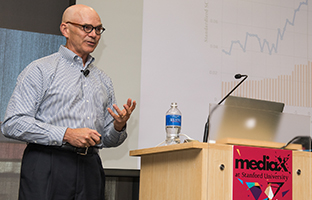Constructing a Personal Media Day: Switching Between Work and Play on a Laptop Computer
Familiar technology — laptops, tablets and smartphones increasingly consolidate very different media experiences on single devices. With the availability of a broad range of content on one device, and pause buttons that allow easy switching between work and play, we are now able to experience radically different material without sensing that we’ve missed a thing. Our research group has been tracking how people use personal laptop computers by examining moment-by-moment changes in activity over the course of multiple days. There’s a lot of quick switching between screens that show very different content. I will describe the switching we’ve observed, and discuss individual and situational factors that influence when and how often people switch, and what effects the switches may have on thinking and behavior.
 Byron Reeves is the Paul C. Edwards Professor of Communication in the Department of Communication at Stanford University. He has published extensively in media psychology, and is the author of “The Media Equation” (with Clifford Nass) and “Total Engagement” (with Leighton Read). Dr. Reeves was the co-founder of mediaX in 2000, and is currently studying how people navigate between different media content on single devices. He has worked with several media and technology companies to apply media psychology to new products and services, including two years with Microsoft Research and currently as co-founder of Seriosity, Inc., a company applying principles of entertainment psychology to enterprise software.
Byron Reeves is the Paul C. Edwards Professor of Communication in the Department of Communication at Stanford University. He has published extensively in media psychology, and is the author of “The Media Equation” (with Clifford Nass) and “Total Engagement” (with Leighton Read). Dr. Reeves was the co-founder of mediaX in 2000, and is currently studying how people navigate between different media content on single devices. He has worked with several media and technology companies to apply media psychology to new products and services, including two years with Microsoft Research and currently as co-founder of Seriosity, Inc., a company applying principles of entertainment psychology to enterprise software.